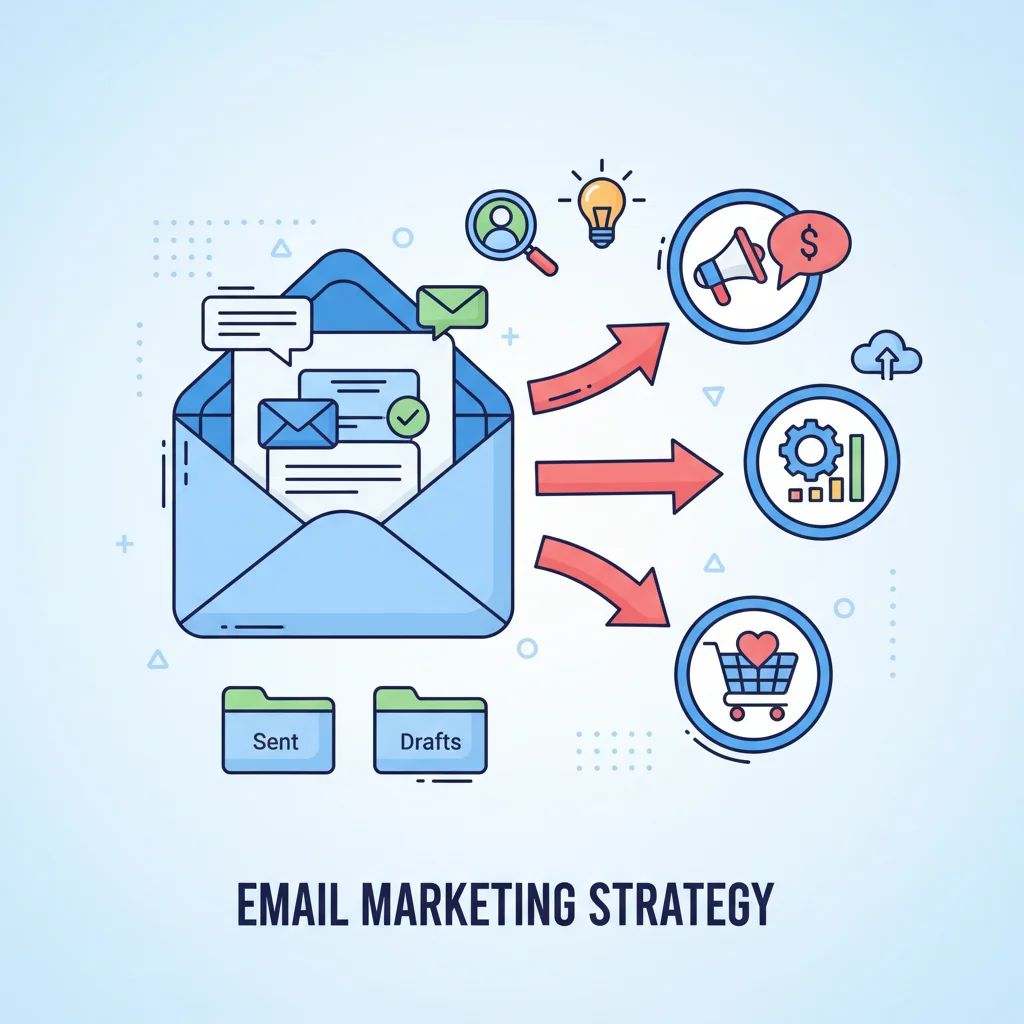Now Reading: The Smart Marketer’s Guide to Measuring Email Marketing ROI
-
01
The Smart Marketer’s Guide to Measuring Email Marketing ROI
The Smart Marketer’s Guide to Measuring Email Marketing ROI

For every $1 spent on email marketing, businesses see an average return of $36 to $40. That’s a staggering 3600% ROI! Yet surprisingly, many marketers don’t know how to measure email marketing ROI properly, potentially leaving thousands of dollars on the table. I’ve spent years helping businesses track and optimize their email performance, and today I’m sharing my proven formula for ROI success.
Key Takeaways
- To measure email marketing ROI, use this formula: ROI = [(Revenue – Cost) / Cost] × 100
- The average email marketing ROI is between $36-$40 for every $1 spent, making it one of the highest-performing marketing channels
- Track both direct costs (software, design) and indirect costs (staff time) for accurate calculations
- Use UTM parameters, coupon codes, and platform integrations to attribute revenue correctly
- Segment your campaigns when measuring ROI to identify your highest-performing email types
What is Email Marketing ROI
Email marketing ROI (Return on Investment) is a metric that shows how much revenue you generate compared to what you spend on your email campaigns. It’s basically the profit you make from your email marketing efforts, expressed as a percentage of your costs.
In simple terms, it tells you whether your email marketing is worth the investment. And spoiler alert: it usually is! According to multiple studies, email marketing consistently delivers one of the highest ROIs among all marketing channels, with businesses seeing returns between $36 and $40 for every dollar spent[1].
Some businesses even report ROIs as high as $68 for each dollar spent on email marketing. That’s pretty darn impressive!
Why measuring email ROI matters
I can’t stress this enough-if you’re not measuring your email marketing ROI, you’re basically flying blind. Here’s why it matters:
- Budget justification: Need to convince your boss (or yourself) that email marketing deserves investment? ROI data is your best friend.
- Strategy optimization: When you know which campaigns deliver the highest returns, you can double down on what works.
- Resource allocation: Should you spend more on design, copywriting, or list building? ROI data helps you decide.
- Performance benchmarking: Compare your results against industry averages to see if you’re ahead of the curve.
One of my clients was about to cut their email program entirely until we calculated their ROI and discovered it was actually their most profitable channel. Oops! That would’ve been an expensive mistake.
Useful Articles:
The ROI Formula Explained
Alright, let’s get down to business. How exactly do you calculate email marketing ROI?
The basic formula
The formula for calculating email marketing ROI is actually pretty straightforward:
ROI = [(Revenue – Cost) / Cost] × 100
Let’s break this down with a real example:
Say you spend $1,000 on your email marketing campaign (including software, design, copywriting, etc.) and generate $10,000 in revenue from it.
ROI = [($10,000 – $1,000) / $1,000] × 100
ROI = [$9,000 / $1,000] × 100
ROI = 9 × 100
ROI = 900%
This means for every dollar you spent on email marketing, you earned $9 in profit. Not too shabby!
What to include in your costs
To get an accurate ROI calculation, you need to account for ALL costs associated with your email marketing:
- Email platform fees: What you pay for your email service provider
- Design costs: Whether in-house or outsourced
- Copywriting: Time or money spent creating email content
- List building expenses: Lead magnets, opt-in tools, etc.
- Staff time: Don’t forget to factor in hours spent on email strategy and management
- Technical integrations: Any additional tools you use specifically for email
I often see marketers underestimating their true costs by forgetting to include their own time or their team’s time. If you spend 10 hours a week on email marketing and your hourly rate is $50, that’s $500 weekly that should be factored into your ROI calculation.
Tracking revenue from email
This is where things get a bit trickier. To accurately measure revenue generated from your email campaigns, you need proper tracking in place:
- UTM parameters: Add these to your email links to track traffic and conversions in Google Analytics
- Coupon codes: Create unique codes for your email campaigns to track offline or phone orders
- Platform integrations: Connect your email platform with your e-commerce system
- Attribution models: Decide how to attribute sales when email is just one touchpoint in the customer journey
One method I love is creating dedicated landing pages for email campaigns. This makes it super easy to track conversions that came specifically from your emails.
Advanced ROI Measurement Techniques
Once you’ve mastered the basics, it’s time to level up your ROI measurement game.
Segmenting your ROI analysis
Not all email campaigns are created equal. To get truly actionable insights, segment your ROI analysis by:
- Campaign type: Promotional vs. nurture vs. transactional emails
- Audience segment: New subscribers vs. loyal customers vs. inactive users
- Product category: Which product lines generate the highest email ROI?
- Time period: Monthly, quarterly, or seasonal analysis
I worked with an e-commerce client who discovered their abandoned cart emails had a 3,000% ROI, while their newsletter had only a 200% ROI. Guess where they started investing more resources?
Beyond direct revenue
While direct sales are important, don’t forget about other value metrics that contribute to long-term ROI:
- Lead generation: How many qualified leads do your emails produce?
- Customer retention: What’s the value of customers who stay engaged through email?
- Referrals: Do your emails encourage sharing and new customer acquisition?
- Brand building: How do emails contribute to overall brand awareness and loyalty?
These “soft” metrics can be harder to quantify, but they definitely impact your bottom line over time.
Lifetime value considerations
One of the most sophisticated approaches to email ROI is factoring in customer lifetime value (CLV). Here’s how:
- Calculate the average CLV of customers acquired through email
- Compare it to the CLV of customers acquired through other channels
- Factor this difference into your long-term ROI calculations
This approach often reveals that email marketing’s true ROI is even higher than the immediate revenue suggests.
Useful Articles:
Setting Up Proper Tracking Systems
You can’t improve what you don’t measure, and you can’t measure what you don’t track. Let’s set up a proper tracking system.
Essential tracking tools
To accurately measure email marketing ROI, you’ll need:
- Google Analytics: Set up e-commerce tracking and goal values
- Email platform analytics: Most ESPs provide basic performance metrics
- CRM integration: Connect email engagement to customer data
- E-commerce platform: Link purchase data back to email campaigns
The magic happens when these systems talk to each other, giving you a complete picture of the customer journey from email open to purchase.
UTM parameters explained
UTM parameters are special tags you add to your links that help analytics tools track where traffic comes from. For email ROI tracking, I recommend using:
- utm_source: Usually “email” or your ESP name
- utm_medium: “email” or “newsletter”
- utm_campaign: Specific campaign name
- utm_content: Specific link or placement within the email
For example:
https://yourwebsite.com/product?utm_source=mailchimp&utm_medium=email&utm_campaign=summer_sale&utm_content=hero_button
This level of detail helps you track not just which campaigns perform best, but which specific elements within those emails drive conversions.
Attribution models
Attribution can get complicated when customers interact with multiple marketing channels. Consider these models:
- First-touch: Gives credit to the first channel that reached the customer
- Last-touch: Gives credit to the final touchpoint before purchase
- Linear: Distributes credit equally across all touchpoints
- Time-decay: Gives more credit to touchpoints closer to the conversion
- Position-based: Gives more credit to first and last touchpoints
For email marketing, I often recommend a position-based model that acknowledges both the role of email in initiating customer relationships and in closing sales.
Optimizing Email Campaigns for Higher ROI
Now that you know how to measure email marketing ROI, let’s talk about how to improve it!
List segmentation strategies
Sending the right message to the right people is ROI 101. Segment your list by:
- Purchase history: What have they bought before?
- Engagement level: How often do they open and click?
- Demographics: Age, location, gender if relevant
- Interests: What content do they engage with most?
My client in the fashion industry saw their ROI jump from 400% to 1200% just by segmenting their list and sending more targeted offers. The extra effort pays off big time.
Personalization tactics
Generic emails = generic results. Try these personalization approaches:
- Dynamic content: Show different products based on past behavior
- Personalized subject lines: Include names or relevant details
- Behavior-triggered emails: Send based on specific actions
- Purchase recommendations: Suggest products similar to past purchases
Personalization isn’t just about saying “Hi [First Name]” anymore. It’s about delivering genuinely relevant content that drives conversions.
Testing for ROI improvement
Never stop testing! Here are some elements to test for ROI impact:
- Subject lines: Test length, personalization, and emotional appeals
- Send times: Find the optimal day and time for your audience
- Call-to-action: Test button color, placement, and wording
- Email length: Short and sweet vs. detailed information
- Frequency: How often should you email for maximum ROI?
I always recommend testing one element at a time and measuring the impact specifically on ROI, not just open rates or clicks.
Useful Articles:
Common ROI Calculation Mistakes
Even experienced marketers make these ROI measurement mistakes. Don’t be one of them!
Overlooking hidden costs
Many marketers underestimate their true email marketing costs by forgetting:
- Time costs: Hours spent planning, creating, and analyzing campaigns
- List maintenance: Costs of keeping your list clean and compliant
- Technical debt: Time spent troubleshooting or fixing email issues
- Opportunity costs: What else could you be doing with that time and money?
Be honest about ALL your costs for an accurate ROI picture.
Attribution errors
Attribution mistakes can seriously skew your ROI calculations:
- Taking full credit when email was just one touchpoint in a multi-channel journey
- Ignoring assisted conversions where email played a supporting role
- Not accounting for offline conversions triggered by email campaigns
- Overlooking delayed conversions that happen days or weeks after email engagement
Setting up proper multi-touch attribution helps avoid these pitfalls.
Short-term thinking
Perhaps the biggest mistake is focusing only on immediate returns while ignoring:
- Brand building benefits that pay off over time
- Relationship development that leads to future sales
- Customer retention value that reduces acquisition costs
- Referral potential from satisfied email subscribers
The true ROI of email marketing often reveals itself over months and years, not days and weeks.
Industry Benchmarks and Expectations
How does your email marketing ROI stack up against others in your industry? Let’s look at some benchmarks.
Average ROI by industry
While the overall average email marketing ROI is around $36-$40 for every dollar spent, it varies by industry:
- Retail/E-commerce: $45 per dollar spent
- Financial services: $36 per dollar spent
- Travel and hospitality: $53 per dollar spent
- Media and publishing: $32 per dollar spent
- B2B services: $38 per dollar spent
Don’t panic if you’re not hitting these numbers yet-they represent mature email programs. The important thing is to establish your baseline and work on improving from there.
Factors affecting ROI
Several factors influence your potential ROI:
- List quality: Engaged subscribers = higher ROI
- Product price point: Higher-priced items can drive higher ROI
- Purchase frequency: Regular purchases compound ROI
- Sales cycle length: B2B with longer cycles may see delayed ROI
- Email program maturity: ROI typically improves over time
Understanding these factors helps set realistic expectations for your program.
Setting realistic goals
Based on your industry and specific circumstances, set progressive ROI goals:
- New programs: Aim for breaking even in the first 3-6 months
- Developing programs: Target 200-300% ROI within a year
- Mature programs: Push for 500%+ ROI through optimization
- Advanced programs: 1000%+ ROI through sophisticated segmentation and automation
Remember that improvement over time is more important than hitting a specific benchmark right away.
Tools To Help Measure Email Marketing ROI
Let’s talk about some specific tools that can make ROI measurement easier.
Email service providers
Most modern ESPs offer some level of ROI tracking:
- Mailchimp: Provides revenue tracking when connected to e-commerce platforms
- Omnisend: Offers detailed ROI reporting with e-commerce integration
- GetResponse: Features conversion tracking and ROI calculation
- Klaviyo: Specializes in e-commerce ROI tracking and optimization
Check if your current ESP offers these features-you might already have access to powerful ROI tools.
Analytics platforms
For more advanced tracking, consider:
- Google Analytics 4: Set up e-commerce tracking and conversion goals
- Mixpanel: Track user journeys across channels including email
- Amplitude: Analyze user behavior patterns and conversion paths
- Hotjar: See how users interact with your landing pages from email
The combination of email platform data and website analytics gives you the most complete picture.
CRM integrations
Connect your email marketing to your customer database:
- Salesforce: Track email influence on sales opportunities
- HubSpot: See email’s role in the complete customer journey
- Zoho CRM: Connect email engagement to customer records
- Pipedrive: Track email’s contribution to your sales pipeline
These integrations are especially valuable for B2B companies with longer sales cycles.
Practical ROI Calculation Examples
Let’s walk through some real-world examples to make this concrete.
E-commerce example
An online clothing retailer runs a summer sale email campaign:
- Costs: $2,000 (platform fees, design, copywriting, staff time)
- Revenue: $30,000 (tracked through UTM parameters and coupon codes)
- ROI calculation: [($30,000 – $2,000) / $2,000] × 100 = 1,400%
That’s $14 in profit for every dollar spent-well above the industry average!
B2B example
A software company uses email to nurture leads:
- Costs: $5,000 (platform, content creation, automation setup)
- Revenue: $80,000 (from 2 new clients at $40,000 each)
- ROI calculation: [($80,000 – $5,000) / $5,000] × 100 = 1,500%
Even with higher costs and fewer conversions, the high contract value drives exceptional ROI.
Nonprofit example
A nonprofit organization uses email for fundraising:
- Costs: $1,000 (platform, copywriting, volunteer coordination)
- Donations: $12,000 (tracked through campaign-specific donation forms)
- ROI calculation: [($12,000 – $1,000) / $1,000] × 100 = 1,100%
This demonstrates that ROI isn’t just for commercial enterprises-nonprofits can measure donation ROI too.
Reporting Your ROI Findings
Once you’ve calculated your email marketing ROI, it’s time to share the results.
Creating executive summaries
For leadership teams, focus on:
- Bottom-line impact: Total revenue and ROI percentage
- Trend analysis: How ROI is improving over time
- Competitive advantage: How your ROI compares to industry benchmarks
- Strategic implications: What the ROI data suggests for future investment
Keep it concise-executives want the big picture, not every detail.
Visualizing ROI data
Make your ROI data more digestible with:
- Trend charts: Show ROI evolution over time
- Campaign comparisons: Visualize which campaigns deliver highest ROI
- Funnel visualizations: Illustrate conversion paths from email to purchase
- Heat maps: Highlight highest-performing segments or time periods
Visual representations make patterns and opportunities much clearer than raw numbers.
Acting on insights
The most important part of ROI reporting is the “so what?” factor:
- Identify top performers: Which campaigns or segments deliver highest ROI?
- Spot improvement areas: Where are you leaving money on the table?
- Make recommendations: What specific changes will improve future ROI?
- Set new targets: Based on data, what ROI goals are realistic for next quarter?
Always pair your ROI findings with actionable next steps to maintain momentum.
Measuring email marketing ROI isn’t just about proving value-it’s about continuously improving your results. By following the formula and tracking systems I’ve outlined, you’ll not only know exactly how much return you’re getting from your email investment, but you’ll also gain insights that help you boost those returns over time. So go ahead, crunch those numbers, and watch your email marketing ROI soar!





















